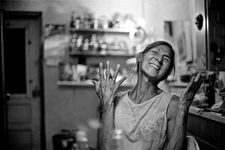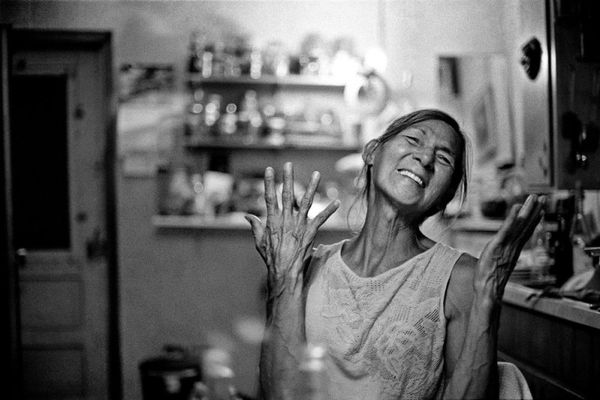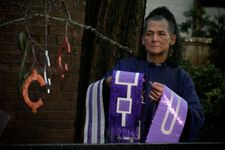
Email us to revise your entry or request it to be deleted.
Canada
Canada
United States of America
Ontario, Canada
Six Nations Grand River Territory, Ontario, Canada

Aiyyana Maracle smiles and throws up her hands in possibly an expression of joy. The portrait is monochrome and the background, while blurry, suggests an interrior space such as a kitchen or studio. Aiyyana is Indigenous, has her hair pulled back and wears a sleeveless top with a subtle floral design.
These are the yes/no and closed vocabulary terms that the Portal uses to filter search
results. They are not
necessarily the words this individual uses for themselves.
Learn more
Trans
Yes
BIPOC
Yes
Deaf and disabled
Yes
Gender identities
trans, Two Spirit
Race/ethnicities
Native American/First Nation/Métis/Inuit, Indigenous
Born November 25th, 1950, on the Six Nations territory on the Grand River near Ohsweken in southern Ontario, Aiyyana grew up in Rochester and Buffalo, New York. Spending time in Vancouver, Toronto, Chippewa territory, and Montreal, in 2010 she returned to the Six Nations reservation. On April 24, 2016, Aiyyana Maracle died surrounded by her loving family and friends. Aiyyana Maracle was a multi-disciplinary artist, scholar, educator, story-crafter and storyteller. For half a century, Aiyyana was actively involved in the merging of Ogwehoweh art and culture into the Euro-centric world and consciousness. For 20+ years she sought that same inclusion for herself and other gender-variant folks by offering an alternate framework to the prevalent Euro-centric view of gender. Aiyyana Maracle was both a maker and keeper of culture. Describing herself in her article “A Journey in Gender” as a “transformed woman who loves women,” Aiyyana’s work steered people towards a decolonized understanding of gender and sexuality. Through her work she argued that in most traditional Indigenous cultures gender identifications fall outside the strict confines of the gender binary and are recognized as both socially and spiritually integral to the culture. Her one-woman show, Chronicle of a Transformed Woman, detailed her use of traditional medicine rituals for transitioning genders while struggling under colonial rule. Aiyyana’s work, which reflected her various transformations in relation to her ongoing process of decolonization, received numerous honours and recognitions. She’s believed to be the first Indigenous person to be awarded the John Hirsch Prize, a national award for the most artistically exciting new director in Canadian theatre (1997). In addition to performing across Ontario and Chippewa territory, in 1998 she exhibited an installation and a performance piece at the Second International Transgendered Art Festival in London, England. She is the author of the book, Chronicle of a Transformed Woman (2000), and many articles.
The Canadian Encyclopedia. “Aiyyana Maracle.” Accessed April 29, 2023. https://www.thecanadianencyclopedia.ca/en/article/aiyyana-maracle.Aiyyana Maracle, multidisciplinary Haudenosaunee artist, performer, storyteller and educator (born 25 November 1950 on Six Nations of the Grand River, ON; died there, 24 April 2016). An Indigenous transgender woman, Maracle created art that focused on the decolonization of gender. Her work received critical acclaim and was widely inspirational. She is believed to have been the first Indigenous woman to have received the John Hirsch Prize. This is a prestigious national award for emerging directors in Canadian theatre. Aiyyana Maracle was born near Ohsweken, Ontario. She was one of the six children of Kitty and Leonard Maracle. She was assigned male at birth. Her family was evicted from the reserve because her father lacked Indian Status. Her family then moved to the US, where Maracle grew up in Rochester and Buffalo, New York. Maracle’s parents made a concerted effort to assimilate into the predominantly white American culture of Northwestern New York State. This was something Maracle considered a necessary survival strategy. Despite this, she maintained her Indigenous identity and resisted attempts at assimilation. Maracle eventually became estranged from her family. She lived in many different places, including Montreal, Vancouver, Toronto, and Chippewa territory. She married twice and had children before beginning her gender transition from male to female in 1990, at the age of 40. Aiyyana Maracle’s visual and performance art challenged the idea of gender-binary as a universal concept. Instead, she argued it was an imported European idea. In many Indigenous cultures, the concept of gender is more fluid and is a component of Indigenous society and spirituality. Gender identification tends to fall outside a two-gender binary in Indigenous cultures. Maracle considered her work to be part of an ongoing process of decolonization. Her work reflected her transformations through life, and Maracle described her life as a “journey in gender.” From 1992 to 2015, Maracle starred in several performances. A well-known one was Gender Möbius (1995). It was performed as part of a multidisciplinary project called Halfbreed. The project focused on the perspectives of transgender people as well as those of mixed Indigenous-white ethnicities. Another performance, ndn wars are alive and … well? (2006-10) featured looped video that commented on colonialization and land dispossession in Canada. Death in the Shadow of the Umbrella (2015) explored the invisibility of Indigenous trans women in popular culture. A talented seamstress, Maracle made her own costumes for her performances. She began curating queer and Indigenous arts festivals in 1992. Examples include The Queer Series/Two Spirit Festival (1993) and women @ the front (2003). She also participated in the Indian Acts: Aboriginal Performance Art conference in 2002. In addition to performance art, Maracle wrote articles and essays on the topic of Indigenous identity and gender. Her one-woman show, Chronicle of a Transformed Woman (2000), focused on her use of Indigenous medicine to assist in transitioning, which she later published as a memoir in 2000. Maracle was a guest lecturer at various Canadian institutions, including Concordia University and the Emily Carr Institute of Art + Design. She received a Masters of Fine Arts from Goddard College in 2005. In 2006, she took an unpaid visiting scholar position at McGill University. Over a career that spanned more than 20 years, Maracle aimed to bring her Indigenous culture into the mainstream through her art. She developed her own vision and voice within the world of contemporary art. Maracle’s work has been displayed in various exhibitions nationally and internationally. Aiyyana Maracle underwent gender affirmation surgery in Brussels, Belgium, in 2010. In the same year, she returned to Six Nations of the Grand River, where she lived with one of her children. Throughout much of her adult life, Maracle coped with diagnosed depression and post-traumatic stress disorder, which she treated with a combination of medication and therapy. Maracle was a grandmother and great-grandmother several times over. She carried on the tradition of Indigenous grandmothers as community leaders. In 2012, Maracle co-facilitated a peer support group called Gender Journey, which was located in Brantford, Ontario, and run out of the Grand River Community Health Centre.
University of Victoria. “Aiyyana Maracle - University of Victoria.” Accessed July 11, 2022. https://www.uvic.ca/transgenderarchives/collections/maracle/index.php.-
Whispers from the Grandmothers: Indigenous Perceptions of Gender
film/video, 2001
Director
Email us to revise your entry or request it to be deleted.


